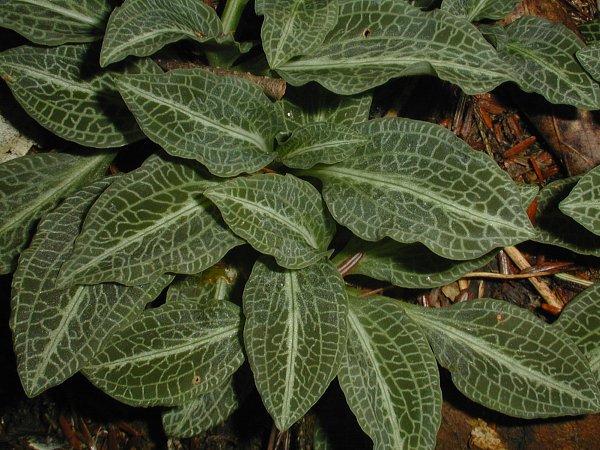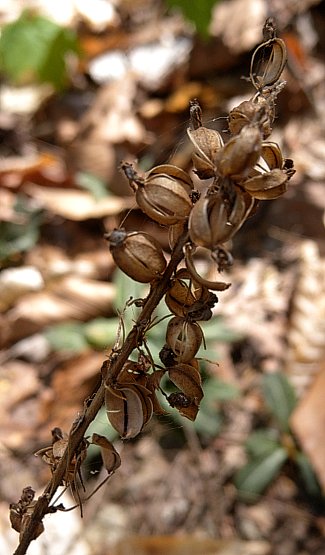
The sepals and petals of these flowers (3 of each per flower) are white or greenish white, while their inferior ovaries are green and glandular-pubescent. The upper sepal and 2 lateral petals of each flower are merged together to form a hood with a slightly upturned outer rim, while the 2 lateral sepals are free and the lower petal forms an open pouch with a minute down-turned beak. These petals and sepals are 3.5-5.5 mm. long; the outer surfaces of the hood and lateral sepals are minutely pubescent. The ovaries are 6-8 mm. long, ellipsoid in shape, and ascending. At the bases of the ovaries, there are ascending floral bracts. These bracts are green, glandular-pubescent, linear-lanceolate in shape, and ascending; they are about the same length as the ovaries. The blooming period occurs during mid- to late summer, lasting about 3-4 weeks. There is no noticeable floral fragrance. Afterwards, the flowers are replaced by seed capsules that become ovoid in shape and brown at maturity. At this time, these capsules split open into several sections to release their minute seeds to the wind. The root system consists of a shallow creeping rhizome with coarse fibrous roots. After flowering, this rhizome forms 1-3 clonal offsets. The clonal offsets become independent on their rhizomes, while the original rhizome dies. The evergreen basal leaves persist for at least 1½ years (at least 2 summers and 1 winter).

Cultivation: The preference is medium shade to dappled sunlight, mesic to dry-mesic conditions, and an acidic loose soil that contains loam, loess (wind-blown silt from a prior ice age), or glacial till with decaying organic matter. The site should be protected from drying winds and it should be relatively humid. The root system of this orchid benefits from an endomycorrhizal association with certain kinds of fungi. This orchid has been successfully cultivated indoors in terrariums (Ugiansky, 2010). It should not be collected from the wild, which can easily destroy local populations.
Range & Habitat: The native Downy Rattlesnake-Plantain is uncommon in Illinois, occurring mostly in northern and southern Illinois (see Distribution Map). Habitats include upland woodlands, north-facing wooded slopes, bluffs, large wooded ravines or sandstone canyons, sandstone glades, and woodlands damaged by logging. On rare occasions, this orchid has also been found in forested bogs. It is often associated with such canopy trees as oaks, pines, Eastern Hemlock (Tsuga canadensis), or sugar maple (Acer saccharum). This orchid usually occurs in high quality natural areas.
Faunal Associations: The small flowers are cross-pollinated by bees, including bumblebees (Bombus spp.) and green metallic bees (e.g., Augochlora spp., Augochlorella spp.); see ILPIN and Homoya (1993) for more information. Aside from this, little is known about floral-faunal relationships for this orchid. The evergreen leaves may be browsed by deer and the rhizomes may be eaten by chipmunks or mice, but additional study of such potential threats is required.
Photographic Location: A rocky bluff dominated by Eastern Hemlock (Tsuga canadensis) at a nature preserve in east-central Indiana.
Comments: While the flowers of Downy Rattlesnake-Plantain are rather small, the reticulated patterns of its basal leaves are very ornate and unique, making this orchid easy to identity. In spite of its common name, this orchid is not closely-related to plantains (Plantago spp.); its leaves have a shape that is similar to some of the common broad-leaved plantains. The common name is also inspired by the superficial resemblance of the leaves' reticulated patterns to the skin of a rattlesnake. The inflorescence of Downy Rattlesnake-Plantain resembles those of the Lady Tresses' Orchids (Spiranthes spp.), although they have dissimilar leaves. The flowers of the former orchid differ from those of the latter by the pouch-like structure of their lower lips, which is lacking in the flowers of Lady Tresses' Orchids. There are other orchid species in the Goodyera genus, but their ranges are located outside of Illinois, mostly to the north or northeast.